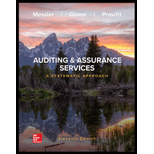
a.
Concept Introduction:
The Securities act of 1933 was based on the concept that if an entity is offering the securities then, it should provide the possible investors proper information about the securities and issuer that helps investors to make an appropriate investment decision. It also ensures to avoid any fraud and misrepresentation occurred in securities that are sold for the public
To describe:Theelement that must be established to support a cause of action based on negligence
b.
Concept Introduction:
The Securities act of 1933 was based on the concept that if an entity is offering the securities then, it should provide the possible investors proper information about the securities and issuer that helps investors to make an appropriate investment decision. It also ensures to avoid any fraud and misrepresentation occurred in securities that are sold for the public
To describe:The element that must be established to support a cause of action based on a rule of 10b-5 violation
c.
Concept Introduction:
The Securities act of 1933 was based on the concept that if an entity is offering the securities then, it should provide the possible investors proper information about the securities and issuer that helps investors to make an appropriate investment decision. It also ensures to avoid any fraud and misrepresentation occurred in securities that are sold for the public
To describe:The correct assertions regarding lack of privitywith regard to cause of action on negligence and fraud.
Want to see the full answer?
Check out a sample textbook solution
Chapter 20 Solutions
EBK AUDITING & ASSURANCE SERVICES: A SY
- QUESTION 1 Examine the information provided below and answer the following question. (10 MARKS) The hockey stick model of start-up financing, illustrated by the diagram below, has received a lot of attention in the entrepreneurial finance literature (Cumming & Johan, 2013; Kaplan & Strömberg, 2014; Gompers & Lerner, 2020). The model is often used to describe the typical funding and growth trajectory of many startups. The model emphasizes three main stages, each of which reflects a different phase of growth, risk, and funding expectations. Entrepreneur, 3 F's Debt(banks & microfinance) Research Business angels/Angel Venture funds/Venture capitalists Merger, Acquisition Grants investors PO Public market Growth (revenue) Break even point Pide 1st round Expansion 2nd round 3rd round Research commercial idea Pre-seed Initial concept Seed Early Expansion Financial stage Late IPO Inception and prototype Figure 1. The hockey stick model of start-up financing (Lasrado & Lugmayr, 2013) REQUIRED:…arrow_forwardcritically discuss the hockey stick model of a start-up financing. In your response, explain the model and discibe its three main stages, highlighting the key characteristics of each stage in terms of growth, risk, and funding expectations.arrow_forwardSolve this problem please .arrow_forward
- Take value of 1.01^-36=0.699 . step by steparrow_forwardsolve this question.Pat and Chris have identical interest-bearing bank accounts that pay them $15 interest per year. Pat leaves the $15 in the account each year, while Chris takes the $15 home to a jar and never spends any of it. After five years, who has more money?arrow_forwardWhat is corporate finance? explain all thingsarrow_forward
 Auditing: A Risk Based-Approach (MindTap Course L...AccountingISBN:9781337619455Author:Karla M Johnstone, Audrey A. Gramling, Larry E. RittenbergPublisher:Cengage LearningBusiness Its Legal Ethical & Global EnvironmentAccountingISBN:9781305224414Author:JENNINGSPublisher:Cengage
Auditing: A Risk Based-Approach (MindTap Course L...AccountingISBN:9781337619455Author:Karla M Johnstone, Audrey A. Gramling, Larry E. RittenbergPublisher:Cengage LearningBusiness Its Legal Ethical & Global EnvironmentAccountingISBN:9781305224414Author:JENNINGSPublisher:Cengage

